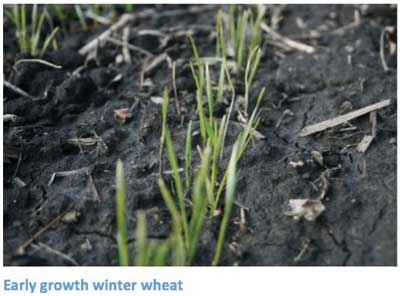
Wheat is one of the field crops that, like the proverbial cat, seems to have nine lives. It is never a good idea to count this crop out until regrowth begins and you can start to see new growth and count stems. Because of bitterly cold temperatures and variable snow cover we experienced this winter, many individuals are justifiably concerned about the condition of the wheat crop.
Throw away the calendar! Wheat development this spring is likely to lag significantly behind normal seasonal development. In most areas this winter, frost penetrated much deeper than usual into the soil. All winter annual or perennial crops should be expected to progress more slowly as these crops break dormancy and resume growth. Give them time.
Snow & Ice. Snow cover on wheat can be very positive if it simply serves as a blanket that insulates against sharp temperature swings. In this way, snow can protect against frost heaving and against injury from bitter cold. However, if snow packs into a dense layer or just becomes too deep, especially under drifts, it will sometimes smother the wheat or foster mold growth. This is a valid concern, in light of the January and February weather.
Ice is almost invariably hard on wheat, particularly where dense sheets form. Wheat will smother under an ice sheet that remains for several days. If sunlight penetrates the ice layer and results in formation of air pockets, wheat will sometimes tolerate ice sheeting. Note where the last remaining snow drifts exist and be sure to include these areas in your spring wheat scouting.
Seeding Depth and Winter Survival. Shallow or uneven seeding depth is the factor most often associated with poor stand establishment and poor winter survival. Wheat should be planted in a firm seedbed at a depth between ½ and 1 ½ inches. Wheat that is planted too shallow tends to be more subject to winter heaving or cold injury. When evaluating wheat survival this spring, be sure to confirm seeding depth, especially in areas where the stand may not be as dense as desired.
Note. Winter wheat requires a period of vernalization in order for it to successfully produce heads. Vernalization is an interval of cool temperatures that occurs after fall seeding while the wheat is actively growing. This process actually can proceed even when there has been little or no above-ground evidence of growth. So, when the wheat stands fill in and green up this spring, as they usually do, we can have a pretty good level of confidence that the crop still has good potential. Based on fall, 2013 observations, most of the planted wheat had a fair chance for establishment and vernalization before the real winter conditions hit.
Plant Population and Productivity. Healthy wheat stands usually have between 30 and 35 plants per square foot. Uniform stands having 20 to 25 plants per square foot will often produce acceptable results, especially if numerous tillers are formed. Be aware that late germinating wheat is less likely to have good tiller development, so any injury to the main stem will have a proportionately greater impact on yield.